Marijuana, also known as weed or pot, refers to the dried leaves, flowers, stems, and seeds from the hemp plant Cannabis sativa, which contains the psychoactive and mind-altering chemical, delta-9-tetra-hydro-cannabinol, or THC, as well as other related compounds.
I'm completely biased when it comes to marijuana as I grew up around it all my life and have only seen how beneficial it has been to my family and all the people in my community. But for many, the thought of legal marijuana is still a scary proposition that looms on the national horizon of the legalization movement.
Although marijuana has been demonized in the press for decades as a gateway drug that will rob our youth of their innocence and ambition, people have come to realize how benign and beneficial the plant actually is. This post hopes to introduce the uninformed to my old friend cannabis and show that the American people have finally come to their senses and are ready to embrace this plant for the good friend it actually is.
So, say hello to my little friend.
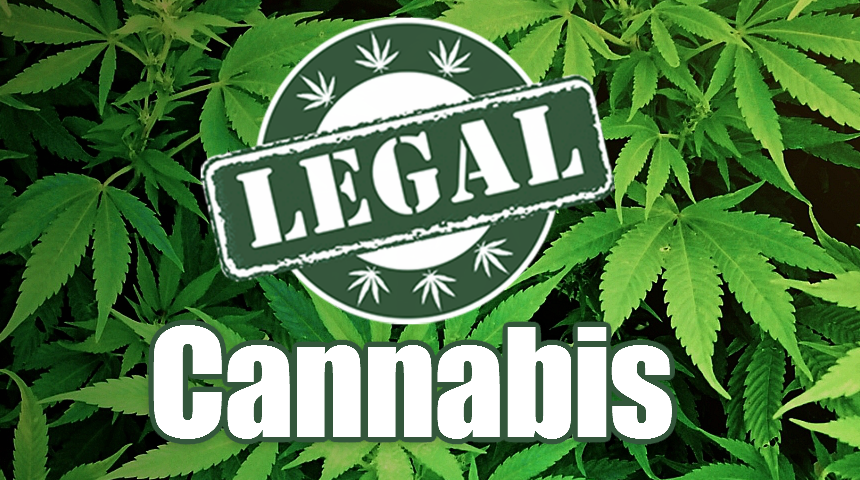
When examining a cannabis bud you'll notice a complex combination of different parts; the fiery orange hairs, the sugary crystals, the chunky knobs enveloped by tiny leaves, but what are these formations and what functions do they serve?
Here six quick facts and we hope can bring you a little bit closer to your favorite strain's source.
1 - Male Versus Female#
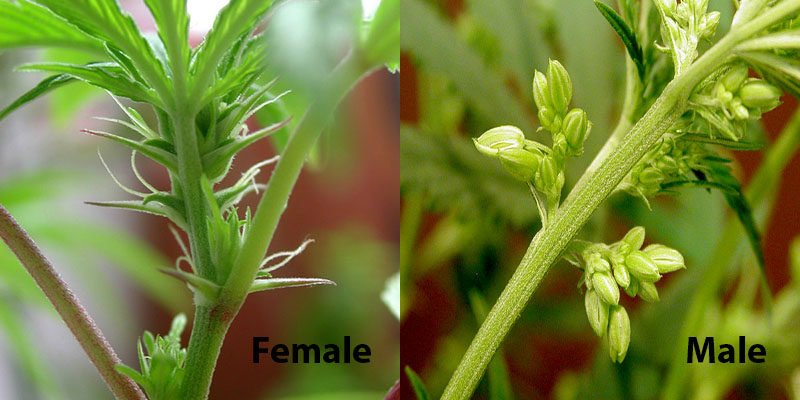
Cannabis plants can be male female or both but the one that's in your stash jar now should be female.
Female cannabis plants are the ones that produce the large resin secreting flowers that are trimmed down to the smaller more round in pointed buds you are used to seeing. Male plants on the other hand produce smaller spheres near the base of the leaves.
The male plants also pollinate the females to initiate seed production, but the potent flowers we consume come from the seedless female plants which grow large, cannabinoid-rich buds without any seeds.
Growers can ensure the sex of their plants by growing clones - the genetically identical clippings from a parent strain.
2 - Stems and Nodes#
The cannabis plant is made up of several structures many of which we can find on any ordinary flowering plant, but the cannabis plant itself goes on long skinny stems with large iconic family leaves which extend out from areas called nodes.
3 - Colas
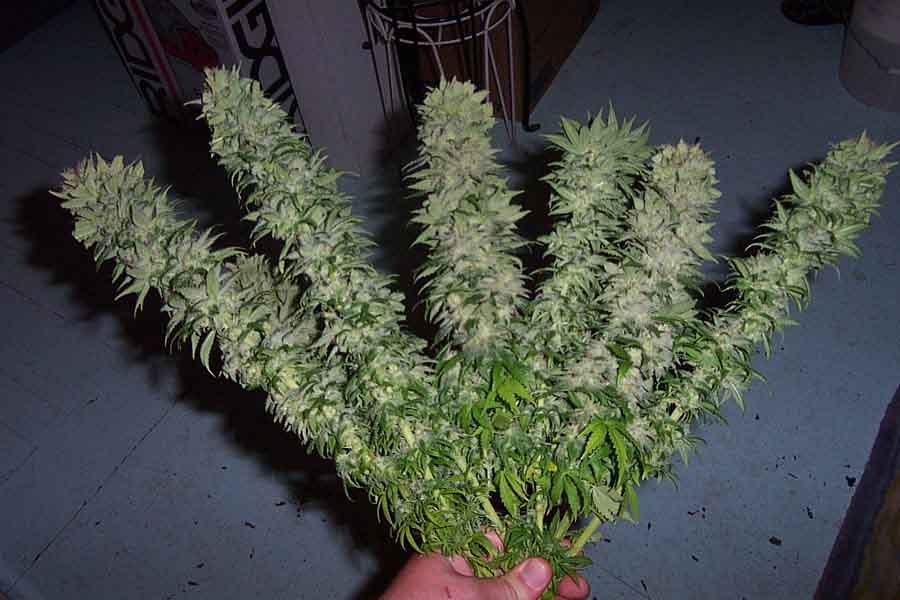
Not soda! We're talking about the terminal bud.
Cola refers to the plant's bud site where tight female flowers bloom. The main cola sometimes called the apical bud, forms at the very top of the plant while smaller colors occur along the binding sites each node below.
The number and size of cannabis colas can be increased through a variety of growing techniques.
4 - Calyxes
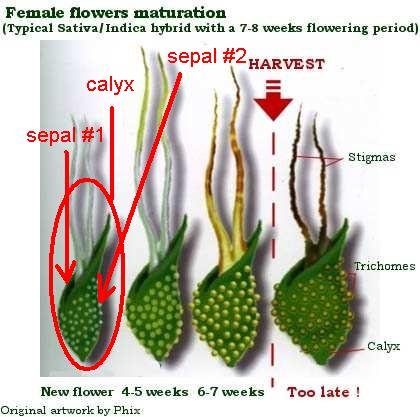
To the untrained eye cannabis buds just look like a tangle of leaves, but the calyx is what actually comprises the female flower.
Look closely underneath those tiny leaves, called sugar leaves, and you find those tear shaped nodules. These are the calyxes and they come in many different shapes sizes and colors.
Calyxes typically contain high-concentrations of trichomes the glands that secrete THC and the other cannabinoids we treasure.
5 - Pistils
Out from the calyxes peak tiny red/orange hairs - vibrant strands called pistils And they served to collect pollen from males. Pistols begin with the white coloration and progressively darken to yellow, amber, and brown over the course of the plant's maturation.
While they do play an important role in reproduction, pistils actually bring very little to the flower's potency and taste, but they do add some color and influence the visual appeal each strain.
6 - Trichomes#
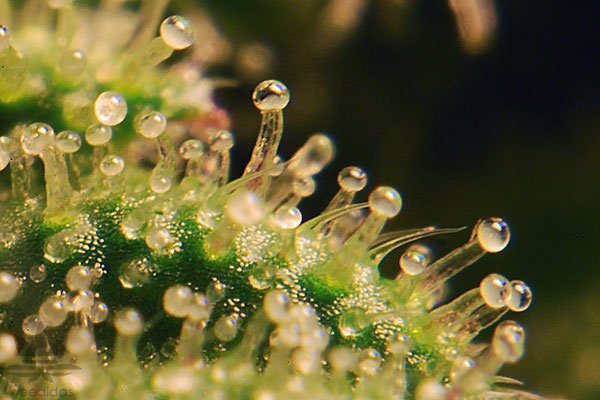
Trichomes, despite their miniscule size, are hard to miss, forming a blanket of crystal resin on a cannabis bud.
This resin, or kief when dry, is secreted through translucent mushroom-shaped glands on the leaves, stems, and calyxes.
Trichomes were originally developed to protect the plant against predators and the elements. These clear, bulbous globes ooze aromatic oils called terpenes as well as therapeutic cannabinoids like THC and CBD.
The basis of concentrate production depends on the trichomes and the potent sugar-like resin.
What US Citizens Think About Cannabis
This plant has such a long, documented history of usefulness to humans that is amazes me we've forgotten our old friend and turned our backs to her benefits until more recently.
The failed and costly drug wars have awakened people to the falseness of fighting a war on our freedoms and, once again, the truth prevails, or as I like to put it, the truth talks and the bullshit walks.
Let’s take a fun look at some interesting facts about the world’s most beloved plant.
Researchers find that 42% of people surveyed in the U.S. have tried marijuana at least once. In contrast, only 20% of people surveyed in the Netherlands, where weed has been legal for 38 years, reported having tried pot; in Asian countries, such as Japan and China, marijuana use is virtually "non-existent," the study finds.
Out of the estimated 22 million pounds of marijuana grown each year in the United States, nearly 80% comes from California, Tennessee, Kentucky, Hawaii and Washington.
An estimated one-third of America’s weed is grown indoors.
In California, indoor marijuana grow modules account for about 9 percent of household electricity use.
In Colorado, where the recreational use of marijuana was recently legalized, only 9% of residents are regular pot smokers. Denver has surpassed Amsterdam as the capital of the marijuana world. The city has more than 300 stores, called dispensaries, outnumbering pharmacies, liquor stores, public schools and even Starbucks.
In Colorado, recreational pot has a hard time competing with medical marijuana, which has been legal since 2000 and whose tax rate is 78% lower.
The use among teens has not increased with the legalization of recreational weed.
Legalizing marijuana federally would generate billions of dollars in federal and state tax revenue per year.
California was the first U.S. State that banned marijuana a century ago.
In the U.S., a sentence of life in prison without parole was given for trying to sell $10 of marijuana to an undercover officer. Over 800,000 people are arrested for marijuana in the US each year. Support for marijuana legalization is rapidly outpacing opposition.
A slim majority (52%) of Americans say the drug should be made legal, compared with 45% who want it to be illegal. Opinions have changed drastically since 1969, when Gallup first asked the question and found that just 12% favored legalizing marijuana use.
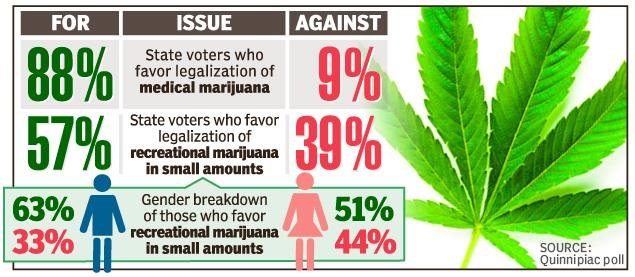
Smoking up could be a very different experience for men and women, according to a 2014 study in the journal, Drug and Alcohol Dependence. In research on rats, it was discovered that females were more sensitive to cannabis' painkilling qualities, but they were also more likely to develop a tolerance for the drug, which could contribute to negative side effects and dependence on marijuana.
Study after study finds that marijuana is less harmful than alcohol and tobacco. The beer and alcohol industries are two of the biggest anti-marijuana advocates. Obviously, marijuana is a serious threat to alcohol sales.
Due to its safer nature, marijuana is often suggested as an alternative to alcohol. However, heavy use can be harmful. Since pot smoke is chemically very similar to tobacco smoke, heavy pot smokers are at risk for some of the same health effects as cigarette smokers, like bronchitis and other respiratory illnesses. Though, the risks are from smoking, which isn't the only way to use marijuana.
Another hazard: car accidents caused by driving while high, though the risk is lower than from drunk driving. A smoker would theoretically have to consume nearly 1,500 pounds of marijuana within about fifteen minutes to induce a lethal response.
The main psychoactive chemical in marijuana, responsible for most of the intoxicating effects sought by recreational users, is delta-9-tetrahydro-cannabinol, or THC. The Cannabis plant preparation also contains at least 65 other compounds that are chemically related to THC, called cannabinoids.
THC is chemically similar to a class of substances found naturally in our nervous system called endogenous cannabinoids, or endocannabinoids, of which anandamide is best known so far. The endocannabinoids are part of a newly discovered system named the Endocannabinoid system, or ECS.
A human brain contains billions of nerve cells, or neurons, which communicate via chemical messages, or neurotransmitters.
When a neuron is sufficiently stimulated, a neurotransmitter is released into the synaptic cleft - a space between neurons. The neurotransmitter then binds to a receptor on a neighboring neuron, generating a signal in it, thereby transmitting the information to that neuron.
Neuron communication is essential to all brain activities. The ECS acts as a modulator of this neurotransmission. When the postsynaptic neuron is activated, endocannabinoids are produced, released, and travel back to the presynaptic neuron where they activate cannabinoid receptors. By doing so, they control what happens next when the presynaptic cell is again stimulated.
The general effect is a decrease in the release of neurotransmitters such as GABA or glutamate. In other words, the ECS acts as a “brake”, slowing down neuronal activities, preventing neurons from excessive firing.
Some examples of ECS functions include:
- Pain modulation: cannabinoids SUPPRESS pain signal processing, producing pain relief effects.
- Stress and anxiety reduction: while response to stressful stimuli is necessary for an organism to react appropriately to a stressor, chronicMarijuana, also known as weed or pot, refers to the dried leaves, flowers, stems, and seeds from the hemp plant Cannabis sativa, which contains the psychoactive and mind-altering chemical, delta-9-tetra-hydro-cannabinol, or THC, as well as other related compounds.
Long-term effects of marijuana in humans are still debatable mostly due to limitations of conducting research on human beings. While recreational use of marijuana is WITHOUT doubt harmful, the Cannabis plant may be a valuable source of medicines.
Currently, the two main cannabinoids from the marijuana plant that are of medical interest are THC and cannabidiol, or CBD. These chemicals are used to increase appetite and reduce nausea in patients undergoing cancer chemotherapy. They may also be useful in reducing pain and inflammation, controlling epileptic seizures, and possibly even treating autoimmune diseases and cancers.
Hope you enjoyed this post and follow me for more posts in the future about cannabis creating jobs in the US.
Related Posts
Hemp Can Grow Jobs And Houses Once We Grow Our Awareness Enough To Understand Its Benefits --- by @luzcypher
Sowing Seeds Of The Devils Weed Confessions Of A Second Generation Pot Farmer --- by @luzcypher

